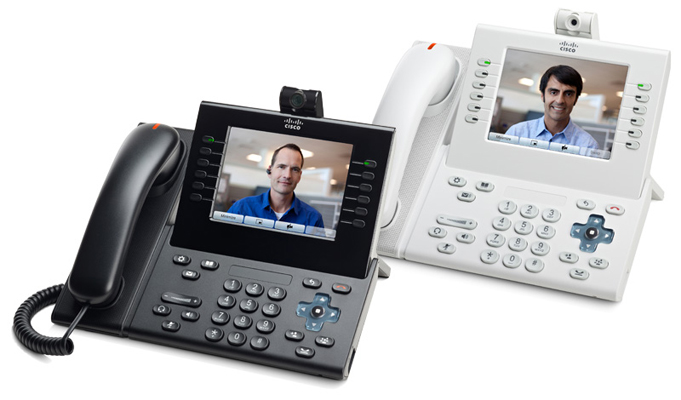Overview:
The Cisco Unified IP Phone 9971 is an executive class collaboration endpoint that provides voice, video, applications and accessories. Highlights include Gigabit Ethernet, Wideband Audio, Color Touchscreen Display, desktop Wi-Fi connectivity along with a new industrial design and user interface designed for simplicity and high usability. Accessories, sold separately, include a standard definition USB camera, Jawbone ICON for Cisco Bluetooth headset, color Key Expansion Module plus support for Bluetooth, USB, Secure Digital Input Output (SDIO) devices. Application support includes XML capabilities.
- Newly developed industrial design and user experience designed for use with its VGA touchscreen display
- H.264 video support for 2-way standard definition calling with USB support for the Cisco Unified IP Camera
- Choice of 802.11 a/b/g desktop wi-fi connectivity or Gigabit Ethernet network connectivity and switch port available for a downstream PC
- Embedded Bluetooth radio and 2 USB ports for headsets and the camera
- Firmware support for XML applications
Advanced Collaborative Media Endpoints
Accelerate decision making with the addition of high-performance business video directly from your desk phone.
The Cisco Unified IP Phone 9900 Series delivers high-quality, interactive multimedia communications and advanced features in an elegant ergonomic design that is user - and eco-friendly.
IP Phone 9971 features:
- Interactive video elevates and personalizes communications (Requires Cisco Unified Video Camera)
- Large backlit, vibrant high-resolution 640 x 480 pixel fully-adjustable color display with touchscreen makes viewing easy
- Built-in 802.11a/b/g Wireless-fidelity (Wi-Fi) radio increases portability and return on investment
- Six tri-color illuminated LED line/feature keys provide at-a-glance status for primary and shared lines
- Dual standard USB 2.0 ports support wired headsets for greater choice and convenience
- Bluetooth 2.0 headset profiles adds freedom at the desk
- High-definition voice (HD voice) provides greater clarity in communications
- Up to three Cisco Unified IP Color Key Expansion Modules for added scalability
- XML and MIDlet multimedia applications transform business processes and enhance user experience
- Gigabit Ethernet switch ports deliver high-speed network connection and PC collocation for reduced infrastructure cost
Eco-friendly features include:
- Reground and recyclable plastics.
- Deep-Sleep power option reduces power consumption up to 90 percent in off-hours versus the phone in active state during the workday.
This product is part of the Cisco Collaboration 2009/2010 Launch. For more details on availability, pricing and ordering, please contact your local Cisco account representative or Channel Partner account representative.
Technical Specifications:
| Product Specifications |
| Protocols |
SIP for signaling
H.264 for video |
| Connectivity |
10/100/1000 wired Ethernet network port plus switched PC port
802.11a/b/g wi-fi |
| Options |
Arctic White or Charcoal Gray color
Slimline (5oz, 140g) or Standard (6oz, 170g) handset |
| Language Support |
Arabic, Bulgarian, Catalan, Chinese (People's Republic of China), Chinese (Hong Kong), Chinese (Taiwan), Croatian, Czech, Danish, Dutch, English - plus localized prompts for the UK, Estonian, French, Finnish, German, Greek, Hebrew, Hungarian, Italian, Japanese, Korean, Latvian, Lithuanian, Norwegian, Polish, Portuguese (Portugal), Portuguese (Brazil), Romanian, Russian, Spanish (Spain), Slovak, Swedish, Serbian (Republic of Serbia), Serbian (Republic of Montenegro), Slovenian, Thai, Turkish |
| Physical Dimensions (HxWxD) |
9.2" (23.4 cm) x 10.33" (26.25 cm) x 1.56" (3.97 cm)
In slab mode with the footstand removed |
| Power |
IEEE Power over Ethernet 802.3af and 802.3at supported, class 4. The 9971 is compatible with both class 3 and class 4 IEEE PoE switch blades and supports both Cisco Discovery Protocol (CDP) and Link Layer Discovery Protocol - Power over Ethernet (LLDP-PoE) |
| Operational Temperature |
32 to 104°F (0 ~ 40°C) |
| Relative Humidity |
10 to 95% (noncondensing) |
| Storage Temperature |
14 to 140°F (-10 to 60°C) |
| Quantity Shipped per Pallate |
320 units |
| Calling Feature Support |
- + Dialing
- Abbreviated dialing
- Adjustable ringing and volume levels
- Adjustable display brightness
- Agent Greeting/Whisper Coaching
- Application Launch Pad
- Auto-answer
- Auto-detection of headset
- Barge
- Callback
- Call forward
- Call forward notification
- Call history lists
- Call park
- Call pickup
- Call timer
- Call waiting
- Caller ID
- Corporate directory
- Conference
- Direct transfer
- Extension mobility service
- Fast-dial service
- Forced access codes/Client matter codes
- Group call pickup
- Hold
- Intercom
- Immediate divert
- Join
- Last-number redial
- Malicious-caller ID
- Message-waiting indicator
- Meet-me conference
- Music on hold
- Mute
- Network profiles (automatic)
- On- and off-network distinctive ringing
- OPickUp
- Personal directory
- Predialing before sending
- Privacy
- Redial
- Ring tone per line appearance
- Service URL
- Shared line
- Time and date display
- Transfer
- Visual Voice Mail
- Voice Mail
|
| Audio Codec Support |
G.711a, G.711u, G.729a, G.729ab, G.722, iSAC and iLBC audio compression codecs. |
| Configuration Options |
- Dynamic Host Configuration Protocol (DHCP) client or static configuration
- Support for online firmware upgrades using Trivial File Transfer Protocol (TFTP)
- Domain Name System (DNS)
- HTTP Firmware Management
|
| Network Features |
- Cisco Discovery Protocol (CDP)
- Link Layer Discovery Protocol Power over Ethernet (LLDP-PoE)
- Transparent secure roaming
- Provisioning of network parameters through DHCP
- Switch Auto-Negotiation
- VPN Client
|
| Security Features |
- Certificates
- Image authentication
- Device authentication
- File authentication
- Signaling authentication
- Media encryption using Secure Real-Time Protocol (SRTP)
- Signaling encryption using Transport Layer Security (TLS) Protocol
- Certificate authority proxy function (CAPF)
- Secure profiles
- Encrypted configuration files
|
| Provisioning and Manufacturing |
- Cisco Unified Communications Manager Express Version Negotiation
- Web server for configuration and statistics
- QoS reporting: jitter, delay, dropped packets, and latency on a per-call basis
- Real Time Control Protocol (RTCP) support and monitoring
- Syslog
|
| Video Standards |
H.264/AVC |
| Frame Rates |
30 fps (maximum) using H.264/AVC for video |
| Frame or Picture Formats |
SQCIF (128 x 96 pixels)
QCIF (176 x 144 pixels)
QVGA (320 x 240 pixels)
SIF (352 x 240 pixels)
CIF (352 x 288 pixels)
VGA (640 x 480 pixels) |
| Wi-Fi Features and Specifications |
| Protocol |
IEEE 802.11a, 802.11b, and 802.11g |
| Frequency band and operating channels |
Uses IEEE 802.11d to identify band ranges and channels |
| Support mode |
IEEE 802.11a
IEEE 802.11b/g
Autosensing, IEEE 802.11b/g preferred over IEEE 802.11a
Received signal strength indicator (RSSI) (default) |
| Data rates |
IEEE 802.11a:
6, 9, 12, 18, 24, 36, 48, and 54 Mbps |
IEEE 802.11b:
1, 2, 5.5, and 11 Mbps |
IEEE 802.11g:
6, 9, 12, 18, 24, 36, 48, and 54 Mbps |
| Nonoverlapping channels |
IEEE 802.11a: Up to 23 (including radar channels)
IEEE 802.11b/g: 3 (Japan uses 4)
(Bluetooth 2.0 also makes use of the 2.4 GHz spectrum, so IEEE 802.11a is recommended when using Bluetooth 2.0) |
| Wireless modulation |
IEEE 802.11a: OFDM
IEEE 802.11b: Direct sequence spread spectrum (DSSS)
IEEE 802.11g: OFDM and DSSS |
| Receiver sensitivity (typical) |
IEEE 802.11a:
6 Mbps: -91 dBm
9 Mbps: -90 dBm
12 Mbps: -88 dBm
18 Mbps: -86 dBm
24 Mbps: -82 dBm
36 Mbps: -80 dBm
48 Mbps: -77 dBm
54 Mbps: -75 dBm |
IEEE 802.11b:
1 Mbps: -96 dBm
2 Mbps: -95 dBm
5.5 Mbps: -90 dBm
11 Mbps: -87 dBm |
IEEE 802.11g:
6 Mbps: -91 dBm
9 Mbps: -90 dBm
12 Mbps: -87 dBm
18 Mbps: -86 dBm
24 Mbps: -82 dBm
36 Mbps: -80 dBm
48 Mbps: -77 dBm
54 Mbps: -76 dBm |
| Transmitter output power |
IEEE 802.11a OFDM:
40 mW (16 dBm)
32 mW (15 dBm)
20 mW (13 dBm)
8 mW (9 dBm)
3.2 mW (5 dBm)
1 mW (0 dBm) |
IEEE 802.11b CCK:
50 mW (17 dBm)
20 mW (13 dBm)
8 mW (9 dBm)
3.2 mW (5 dBm)
1 mW (0 dBm) |
IEEE 802.11g OFDM:
40 mW (16 dBm)
32 mW (15 dBm)
20 mW (13 dBm)
8 mW (9 dBm)
3.2 mW (5 dBm)
1 mW (0 dBm) |
| Range
(Stated Ranges Are from Measured Open-Site Range Testing) |
IEEE 802.11a:
6 Mbps: 604ft (184 m)
9 Mbps: 604 ft (184 m)
12 Mbps: 551 ft (168 m)
18 Mbps: 545 ft (166 m)
24 Mbps: 512 ft (156 m)
36 Mbps: 420 ft (128 m)
48 Mbps: 322 ft (98 m)
54 Mbps: 289 ft (88 m) |
IEEE 802.11b:
1 Mbps: 1,010 ft (308 m)
2 Mbps: 951 ft (290 m)
5.5 Mbps: 919 ft (280 m)
11 Mbps: 902 ft (275 m) |
IEEE 802.11g:
6 Mbps: 709 ft (216 m)
9 Mbps: 650 ft (198 m)
12 Mbps: 623 ft (190 m)
18 Mbps: 623 ft (190 m)
24 Mbps: 623 ft (190 m)
36 Mbps: 495 ft (151 m)
48 Mbps: 413 ft (126 m)
54 Mbps: 394 ft (120 m) |
| Access Point Support |
Cisco 500 Series Wireless Express Access Points
Cisco 1000 Series Lightweight Access Point
Cisco Aironet 1100 Series Access Point
Cisco Aironet 1130 AG Series
Cisco Aironet 1200 Series
Cisco Aironet 1140 AG Series
Cisco Aironet 1230 AG Series
Cisco Aironet 1240 AG Series
Cisco Aironet 1250 Series
Cisco Aironet 1300 Series |
Required versions:
Cisco Wireless LAN Controller (lightweight)
Minimum: Version 4.0.217.0
Recommended: Version 5.1.151.0 or later
Cisco IOS® Software access points (autonomous)
Minimum: Version 12.3(8)JEA
Recommended: Version 12.3(4g)JA1 or later |
| Wireless Security |
Authentication:
Cisco Wireless Security Suite IEEE 802.1X
Lightweight Extensible Authentication Protocol (LEAP) Authentication
Extensible Authentication Protocol and Flexible Authentication with Secure Tunneling (EAP-FAST)
Wi-Fi Protected Access (WPA) Versions 1 and 2: Personal and Enterprise
Cisco Centralized Key Management (CKM) |
Encryption:
40- and 128-bit static Wired Equivalent Privacy (WEP)
Temporal Key Integrity Protocol (TKIP) and Message Integrity Check (MIC)
Advanced Encryption Standard (AES) |
| QoS |
- IEEE 802.11e and Wi-Fi Multimedia (WMM)
- Traffic Specification (TSPEC)
- Enhanced Distributed Channel Access (EDCA)
- QoS Basic Service Set (QBSS)
|
| Radar detection |
Dynamic frequency selection (DFS) and transmit power control (TPC) according to IEEE 802.11h |
Unified Communications Manager Support
- Cisco Unified Communications Manager version 7.1(3a)SU1 or later.
– Some features require more recent version of UC Manager and Dev Pack support. Please check the release notes for more information.
- Survivable Remote Site Telephony (SRST) version 4.3 or later.
- CME 8.6 or later
Licensing
Phone licensing is dependent on the call control platform and its policies. For the Cisco Unified Communications Manager, the 9971 requires 4 Device License Units (DLUs) or an Enhanced IP User Connect License for UCM release 7.1(5) or later. There are no special licenses plus phone bundles for Tier II distributors. The 9971 is not supported on non-Cisco third party call control systems.



